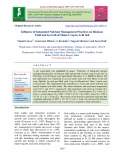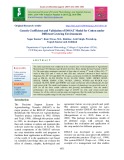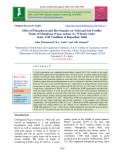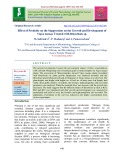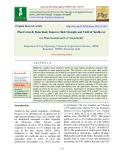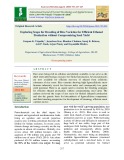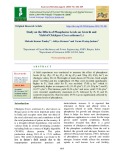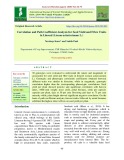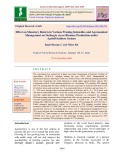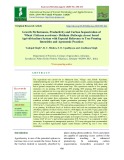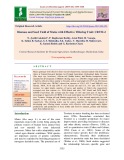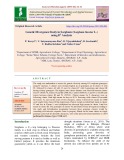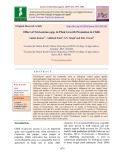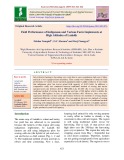
Biomass and seed yield
-
Zinc is required for plant growth, as an activator of several enzymes and is directly involved in the biosynthesis of growth regulators such as auxin which promotes production of more plant cells and biomass that will be stored in the plant organs especially in seeds and their deficiencies may be one of the important reasons of poor yields in light textured soils (Singh and Raj, 2001). Keeping this in view a study was conducted on effect of zinc and sulphur on growth and yields of clusterbean.
 8p
8p  trinhthamhodang1218
trinhthamhodang1218
 26-02-2021
26-02-2021
 14
14
 1
1
 Download
Download
-
A field experiment was conducted during kharif season 2016-17 to study the effect of potassium levels on growth, yield and quality parameters of green gram. The growth and yield attributes like plant height, leaf area, number of nodules, fresh weight of nodules, total biomass production, number of pods, seed yield and dry matter yield were significantly improved by the application of potassium and micronutrient along with RDF.
 6p
6p  trinhthamhodang9
trinhthamhodang9
 16-12-2020
16-12-2020
 21
21
 2
2
 Download
Download
-
Jute cultivation is a labour-intensive activity. Small and marginal farmers extensively practice high density sowing (HDS) by broadcasting jute seed. High plant stand due to HDS at emergence increases major operational expenses of weeding and thinning, sorting and fibre extraction. To investigate effects of low density sowing (LDS)on production potential of fibre and green biomass and possible reduction in man-days and cost of cultivation, field experiment was conducted at ICAR-CRIJAF farm and it was also repeated through farmers’ field trials in four different locations
 9p
9p  trinhthamhodang1216
trinhthamhodang1216
 19-11-2020
19-11-2020
 15
15
 2
2
 Download
Download
-
A pot experiment was conducted to assess ’’Influence of Integrated nutrient management practices on biomass yield and growth of maize crop in acid soil” in The Dept. of Soil Science and Agricultural Chemistry, C.A. BBSR in Kharif. The pot experiment was conducted in an acid sandy loam soil with Maize as the test crop (Hybrid). In each pot filled with 5 kg of collected soil. Then 3 seeds were sown per pot.
 7p
7p  angicungduoc8
angicungduoc8
 07-11-2020
07-11-2020
 21
21
 1
1
 Download
Download
-
Nutrient uptake by crop mainly depends on the dynamics of biomass accumulation during crop growing season. So a field investigation was carried out during kharif 2015-16 at Agricultural Research Institute, Professor Jayashanar telangana state Agricultural University Rajendranagar, Hyderabad with an object to find out the optimum sowing date and plant density.
 6p
6p  nguathienthan8
nguathienthan8
 20-10-2020
20-10-2020
 10
10
 1
1
 Download
Download
-
Powdery mildew and Rust are major diseases of pea of worldwide distribution. Powdery mildew and Rust is an airborne disease. Powdery mildew is a particularly damaging in late sowing or in late maturity varieties. It is caused by Erysisphe pisi. The disease can cause 20-50% yield losses, reducing total yield biomass, number of pods per plant, number of seeds per pod, plant height and number of nodes. The disease also affects green pea quality. Pea rust is characterized by the appearance of two types of symptoms.
 7p
7p  caygaocaolon6
caygaocaolon6
 30-07-2020
30-07-2020
 14
14
 1
1
 Download
Download
-
The model performance in respect of phenology was good with error of ±5% for all the three cotton cultivars and growing environments. Also the model performance was within acceptable range of ±10.0% for LAI, seed cotton yield and biomass for all the cultivars and growing environments. But the model performance was not within acceptable range for the crop sown in 1st week of June.
 11p
11p  trinhthamhodang6
trinhthamhodang6
 09-07-2020
09-07-2020
 20
20
 1
1
 Download
Download
-
A field experiment was conducted during Kharif season 2015. The results of the study indicated the application of phosphorus up to 40 kg P2O5 ha-1 recorded significantly higher number of pods per plant, number of seeds per pod and seed and straw yield, nitrogen, phosphorus and potassium uptake in seed and straw, protein content in seed, microbial biomass carbon, nitrogen and phosphorus in soil as compared to absolute control and 20 kg P2O5 ha-1 but was at par with 60 kg P2O5 ha-1 .
 9p
9p  chauchaungayxua6
chauchaungayxua6
 26-06-2020
26-06-2020
 10
10
 0
0
 Download
Download
-
The present investigation focused the pre-emergent impact of three concentrations (100, 200 and 300 ppm/kg soil) of technical grade of monocrotophos on Vigna mungo plants. The assessment of Monocrotophos stressed Vigna mungo plants inoculated with Rhizobium sp. plant growth suppression was analyzed normally and the Rhizobium treated plant growth and development of Vigna mungo was observed. The plant height, root height, total height, no. of leaf, no. of hairy roots, leaf length, lead width, shoot grifth, number.
 7p
7p  nguaconbaynhay6
nguaconbaynhay6
 24-06-2020
24-06-2020
 8
8
 0
0
 Download
Download
-
KBSH-44, a public sector sunflower hybrid has high biomass production capacity with yield comparable to other popular hybrids. This hybrid is tall with more stalk weight wherein, photo-assimilates are locked up in vegetative parts with a reduced translocation to their productive structures (seed). Any approach, which reduces the plant height, may improve the translocation efficiency to the seed and thus seed yield. In this context, a field experiment was conducted to reduce the plant height by foliar application of plant growth retardants viz.
 9p
9p  nguathienthan5
nguathienthan5
 04-06-2020
04-06-2020
 25
25
 1
1
 Download
Download
-
Rice straw being rich in cellulose and plentily available, it can serve as the chief renewable biomass resource for biofuel production. Several protocols are now available for efficient recovery of ethanol from cellulosic substrates of rice straw. Rice varieties showing high lignocellulosic straw biomass inherently reveal low harvest index and consequently low grain yield potential.
 11p
11p  angicungduoc4
angicungduoc4
 26-04-2020
26-04-2020
 11
11
 0
0
 Download
Download
-
A field experiment was conducted to measure the effect of phosphorus levels [0 kg (P0), 25 kg (P1), 40 kg (P2) and 55kg (P3) P2O5 ha-1 ] on chickpea variety JG-14. The height of main shoots (47.56 cm), fresh weight plant-1 (22.50g) and dry weight/plant (13.50g) were recorded significantly higher in P3. Seed yield for P3 was recorded 17.00 q ha-1 which is significantly higher as compare to P0 (11.45 q ha-1 ), P1 (11.50 q ha-1 ) and P2 (14.77 q ha-1 ). The biomass yield 34.36 q ha-1 and straw yield 17.
 6p
6p  trinhthamhodang4
trinhthamhodang4
 22-03-2020
22-03-2020
 14
14
 1
1
 Download
Download
-
30 genotypes were evaluated to understand the nature and magnitude of association for seed yield and fibre traits in linseed (Linum usitatissimum L). Genotypic and phenotypic correlation coefficients obtained between different traits was similar in direction, while in magnitude, genotypic correlation higher than the corresponding phenotypic correlations.
 10p
10p  chauchaungayxua4
chauchaungayxua4
 18-03-2020
18-03-2020
 9
9
 1
1
 Download
Download
-
The experiment was carried out at dusty acre farm, Department of Forestry, College of Agriculture, J.N.K.V.V. Jabalpur during the year 2014- 2015. Manipulation in agronomical practice like higher seed rate, fertilizer dose with different pruning intensities which can compensate the yield reduction to shade under agrisilviculture system. The experiment consists of four pruning intensities viz., no pruning, 25% pruning, 50% pruning and 75% pruning and one open condition (no tree crop only) in main plot and three levels of fertilizer doses and seed rate viz.
 6p
6p  chauchaungayxua3
chauchaungayxua3
 07-02-2020
07-02-2020
 15
15
 0
0
 Download
Download
-
The experiment was carried out at Akshayvat farm, Village- Arai, Block- Karchana, Allahabad during the year 2016- 2017. In agrisilviculture system, canopy management like pruning is an essential silvicultural management practice for reducing both above and below ground competition with associated crop.
 8p
8p  nguaconbaynhay3
nguaconbaynhay3
 07-02-2020
07-02-2020
 20
20
 2
2
 Download
Download
-
Maize genotype with effective tillers was developed from a natural mutant with ineffective tillers at Central Research Institute for Dryland Agriculture, Hyderabad, India. Teosinte (Zea mays ssp. luxurians), African tall (fodder maize) and Harsha (composite) were included for development of CRIDA tillering maize viz., CRTM-2. Single plant of CRTM2 had five effective tillers similar to Teosinte, with a total height of 1223.5 cm, 62.0 leaves and 25.8 filled cobs. CRTM-2 showed an increase of 530.3, 423.7 and 2086.0% over Harsha, 388.0, 315.8 and 2350 % over African tall and 15.5, 34.
 6p
6p  nguaconbaynhay3
nguaconbaynhay3
 07-02-2020
07-02-2020
 6
6
 0
0
 Download
Download
-
The study was undertaken to assess the genetic diversity among 110 sorghum genotypes using D2 statistics. 4 clusters were formed, highest no of genotypes are in cluster –I with 91, followed by cluster –II with 12, next by cluster-IV with 6 genotypes and cluster-III having solitary genotypes. The highest inter cluster distance was observed between cluster II & IV (4018.74), Cluster II and III (2968.78), I and II (1050.81), I and IV (1332.68) and lowest between cluster III and IV (235.21).
 8p
8p  nguathienthan2
nguathienthan2
 26-12-2019
26-12-2019
 11
11
 0
0
 Download
Download
-
Organic inputs being bulky and concentrated in nature are capable of supplying plant nutrients and enhance soil physical environment. These manures containing organically bound macro and other micro-nutrients which influence plant growth and development, which further also play role in maintaining soil sustainability. The use of PGPR is steadily increased in agriculture and offers an attractive way to supplement and/or replace chemical inputs.
 7p
7p  kethamoi2
kethamoi2
 15-12-2019
15-12-2019
 11
11
 0
0
 Download
Download
-
Trichoderma species are commonly used as biological control agents against phytopathogenic fungi and some isolates are able to improve plant growth. In this study, the effects of seven Trichoderma isolates from Madhya Pradesh was examined in chilli for enhancing seedling and plant vigor via two way introduction methods (inoculating seed with Trichoderma as seed treatment and also seed treatment with three foliar sprays). Different isolates of Trichoderma spp. significantly influenced the root length, shoot length and number of leaves of chilli at seedling stage.
 8p
8p  kequaidan2
kequaidan2
 13-12-2019
13-12-2019
 33
33
 1
1
 Download
Download
-
In Leh district farming is becoming very costly due to scarce population, high cost of labor and lack of well equipped farm machinery. Thus a study was conducted to check the field performance of various tractor operated equipments under Ladakh condition. It was found that indigenous plow has lowest actual field capacity of 0.021 ha/hr. In addition, a comparative study was conducted between traditional method of sowing and tractor operated seed cum fertilizer drill at HMAARI, Leh, SUAST (K).
 6p
6p  kequaidan2
kequaidan2
 11-12-2019
11-12-2019
 12
12
 0
0
 Download
Download
CHỦ ĐỀ BẠN MUỐN TÌM









![Effect of Zinc and sulphur on growth, yield and economics of clusterbean [Cyamopsis tetragonoloba (L.) Taub.] Effect of Zinc and sulphur on growth, yield and economics of clusterbean [Cyamopsis tetragonoloba (L.) Taub.]](https://tailieu.vn/image/document/thumbnail/2021/20210226/trinhthamhodang1218/135x160/2581614343613.jpg)


